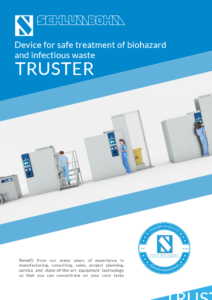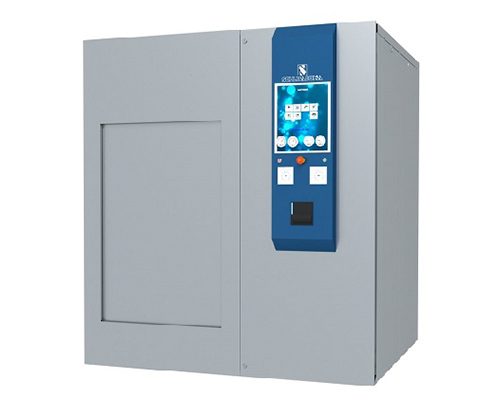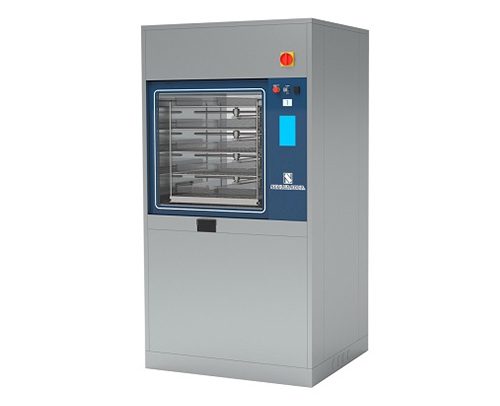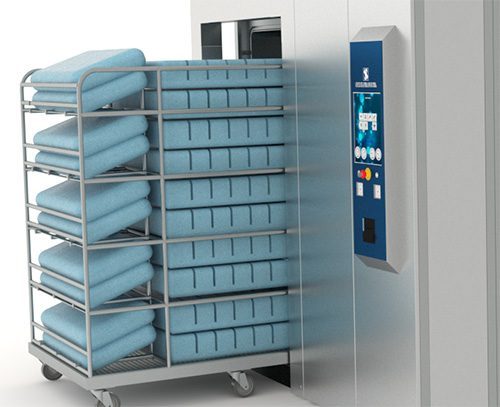SCHLUMBOHM Truster T-Series
Device for safe treatment of biohazard and Infectious waste.
Truster: a technology to be trusted for “biohazard” waste treatment in total safety and respecting eco-sustainability.
The purpose of biohazard waste treatment must be to sterilize them and make them unidentifiable and non-reusable: with Truster all this takes place in a completely hermetic environment through a combined process of mechanical grinding and saturated steam sterilization without any risk of aerobic pollution and of bad smell emission.
Truster consists of a vertical cascade starting from the top of a loading door, a preload chamber, a mechanical grinder group with pushers, a collection chamber with a draining trolley and a drainage port. Being a single environment, all these parts are involved in the phases of each sterilization process and then will eventually be sterilized.
Main operating characteristics of Truster
Combined Shredding and sterilization treatment to guarantees the quality of infectious waste treatment.
The treatment, which takes place in a hermetically sealed environment, eliminates the risk of aerosol transmission and the emission of unpleasant odors.
Mechanical grinding ( shredding) is extremely effective and reduces waste into small pieces, no longer identifiable which will enable guarantee steam penetartion during sterilization process to enable steam to touch directly all microrganism and guarantee no any physical barrier between steam and microrganisms.
Shredding into small pieces of the waste favors the elimination of the air in the preliminary vacuum phase and the penetration of saturated steam in the following phase, guaranteeing the effectiveness of the sterilization process and eliminating the risk of biological pollution or transmission of infections
The device is made with innovative construction techniques, developed specifically for this type of application, with safe sterile drainage discharges and safe sterile air removal ( pre filtered and sterilized air ) to achive a controlled emissions, so as to avoid the risks of environmental pollution.
The machine configuration is acting as pass through of the equipment allows a unidirectional waste path and allows to separate the dirty area where it is loaded from the clean area where treated safe waste in unloaded , to guarantee no cross contamination between untreated waste and treated waste.
The final drying phase leaves the waste as dry ( not wet) eliminating moisture residues and unpleasant odors. During this phase the weight is reduced up to 20% compared to the original one.
Mechanical grinding ( shredding) allows a volume reduction up to 80% compared to the original one.
Being a static device having the only moving part placed inside the sterilization chamber, during use it is safe, away of operators, silent and compact compatible with the work environment.
The floor-level installation of the chamber allows an easy handling of the collection trolley both in the phase of insertion in the chamber and of discharge with the treated material.
“Biohazard” waste
Hospitals, Clinics, Laboratories, Nursing Homes, Dental Centers, Research Centers and other Health Centers are generally producers of potentially infectious hazardous waste known as “Biohazard”.
All materials that directly or indirectly are in contact with the blood or the inside of the human body and are not recoverable or reusable are included in the biohazard waste classification. The departments where most biohazard waste is produced in hospitals are in terms of volumes: operating block, dressing rooms, infectious departments, intensive care units and inpatient departments. According to the statistics the average ratio that we can consider between volume weight is 1 to 10, ie one kilogram corresponds to 10 liters.
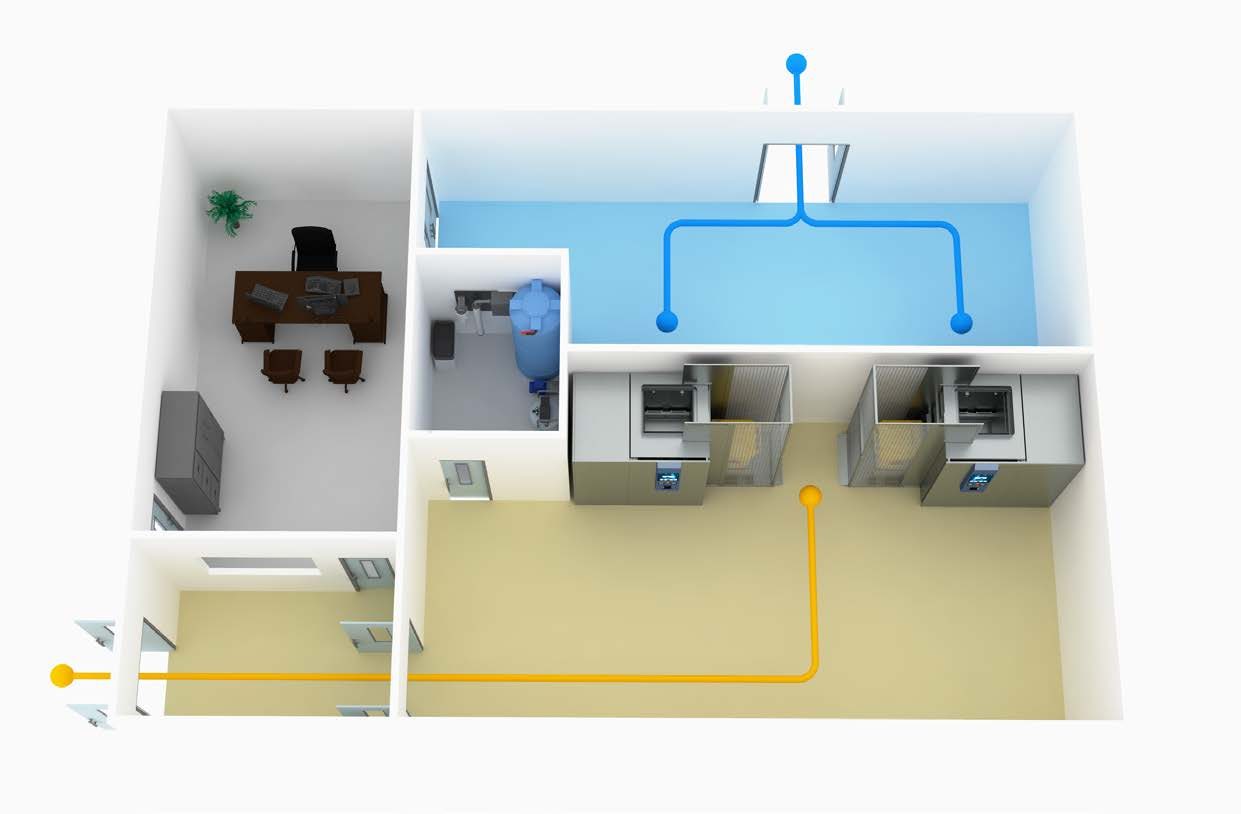
Waste flow
A “biohazard” waste treatment center must provide equipment, flows, routes, procedures and controls that must be put in place in order to be able to credit the treatment of all the material as safe. Truster, being designed to carry out the processing cycle of pass-through materials, actually creates a dirty area separated from the clean area, eliminating the risk of contamination or exchange between treated or untreated biohazard material.
Treatment cycle for solids
Biohazard waste is placed in the load chamber through the door on top of Truster. After completing the loading the door is automatically closed enabling hermetically sealing, the machine run a general self-diagnosis on the functional aspects , shredder cuts waste into small pieces , air removal from waste load begins the phase using the waterless vacuum pump compatible with steam. The removal of air from shredded waste promotes.
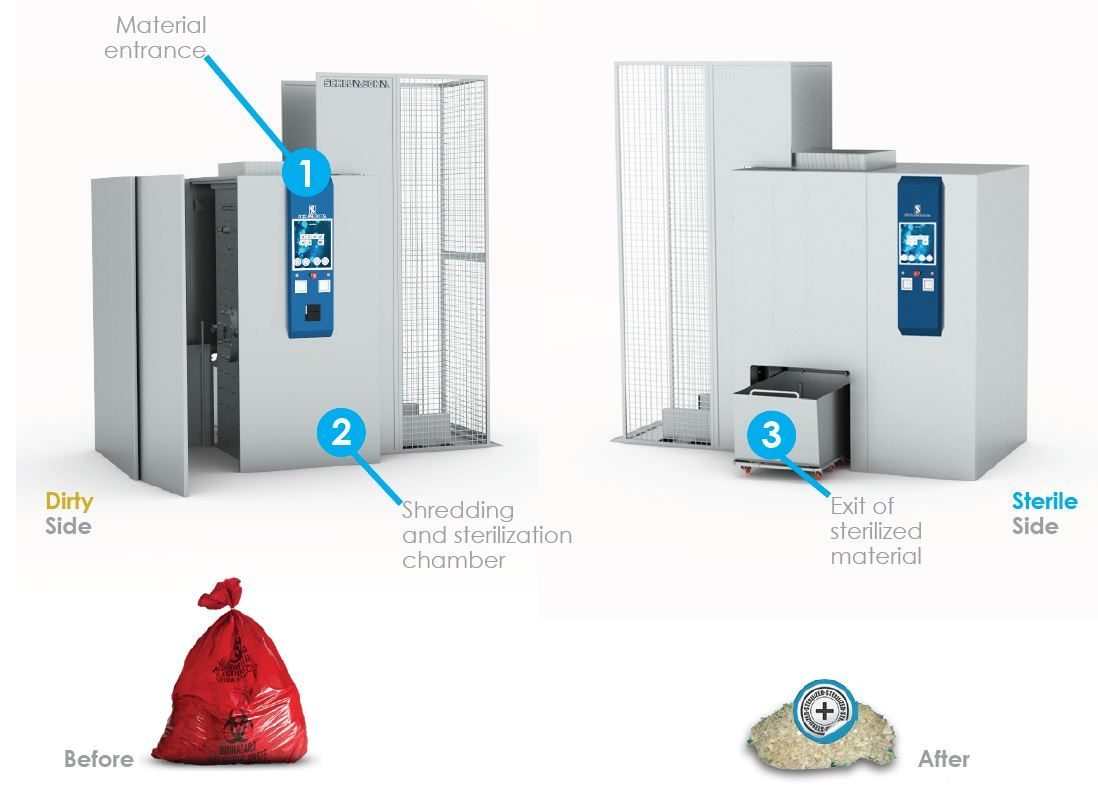
Before passing from the pump and being discharged to the outside, the air is sterilized by an in-line thermal treatment that works at a temperature of 300 ° C.
The temperature and the transit time of the air are controlled by an independent sensors and verified by the formula of the F0; therefore the air discharged in the environment reaches a SAL of 10-6, that is the sterilization level.
The next phase is the introduction of saturated steam into the chamber at the sterilization temperature of 134 ° C and the maintenance of a contact time of 10 minutes with parametric control through independent sensors and with the formula of the F0, this phase permet It reaches a SAL of 10-6 and that is the level of sterilization. The final phase is that of drying which removes moisture from waste leaving it dry and free from unpleasant odors.
Treatment cycle for liquids
Liquid waste, contained in hermetically sealed containers (or not), is placed inside the collection trolley and introduced into the Truster sterilization chamber through the drain port. The appliance, after hermetically blocking the accesses and performed a general self-diagnosis on the functional aspects, begins the vacuum phase to eliminate air from the material. The vacuum is produced by an innovative dry-running mechanical pump compatible with steam. The removal of air from the material promotes the penetration of saturated steam, an optimal condition for correct sterilization.
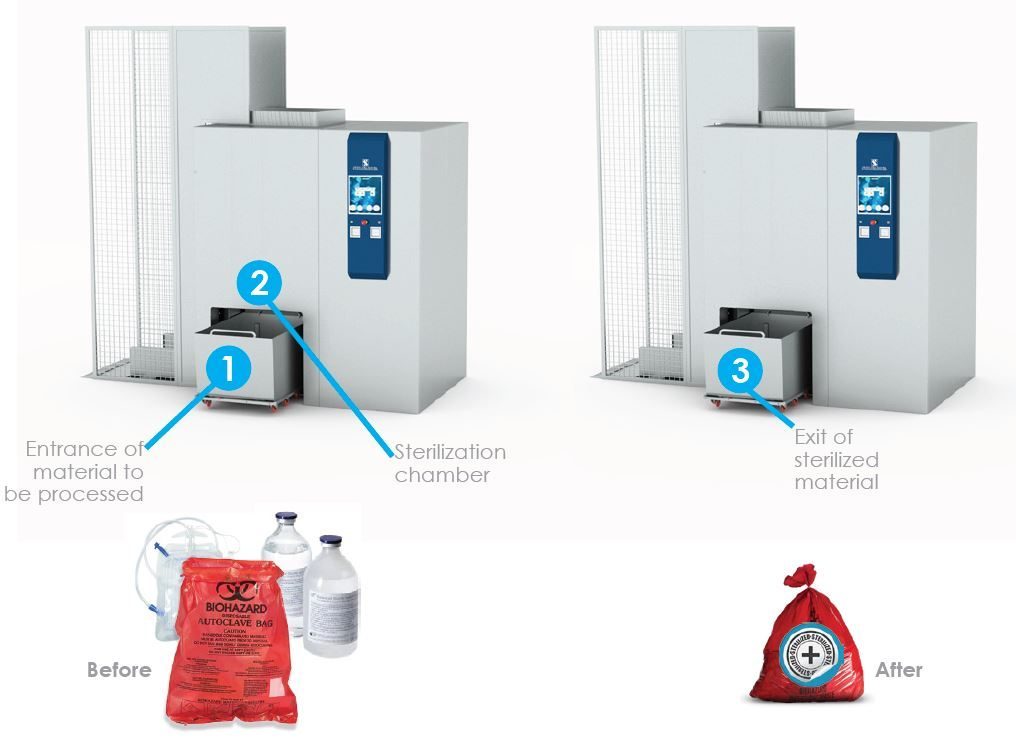
The air, as for the solid cycle, follows a series of treatments to eliminate the risks inherent in the transmission of bacteriological pollution.
The next phase is the introduction of saturated steam into the chamber at the sterilization temperature of 121 ° C and the maintenance of a contact time of 25 minutes with parametric control through independent sensors and with the formula of the F0, this phase allows to reach a SAL of 10-6 and that is the level of sterilization.
During the final drying phase, to preserve the integrity of the containers with the liquids inside and eliminate the humidity, compressed air is introduced and at the same time the vacuum is generated.
Treatment cycle for blood bags
The specific cycle for blood bags provides the same treatment to which liquid waste is subjected.
The result of this treatment is sterilization and the consequent coagulation of the blood contained in the bags.
Subsequently it is possible to proceed with a new cycle of sterilization and shredding for the material that has become solid, reducing the blood bags in small and unidentifiable pieces.
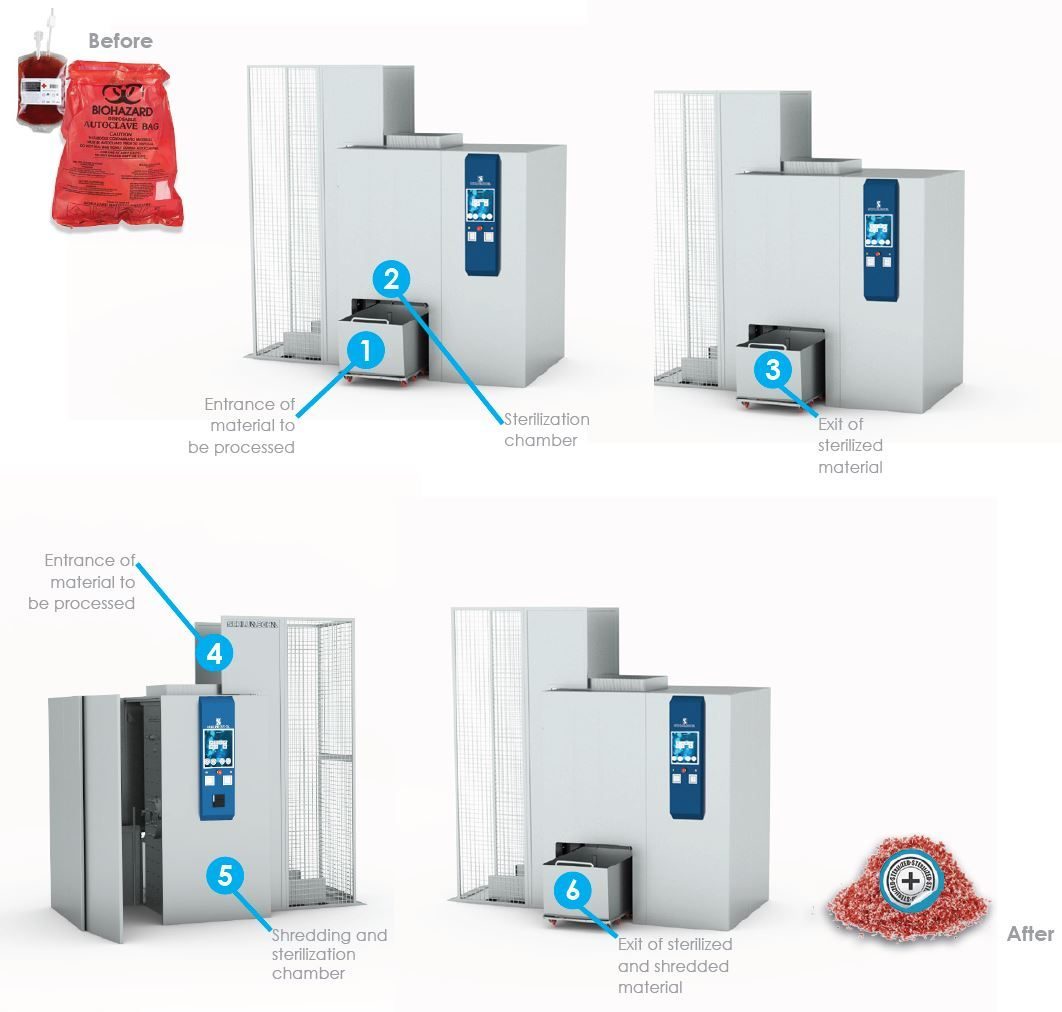
SCHLUMBOHM Truster T-Series
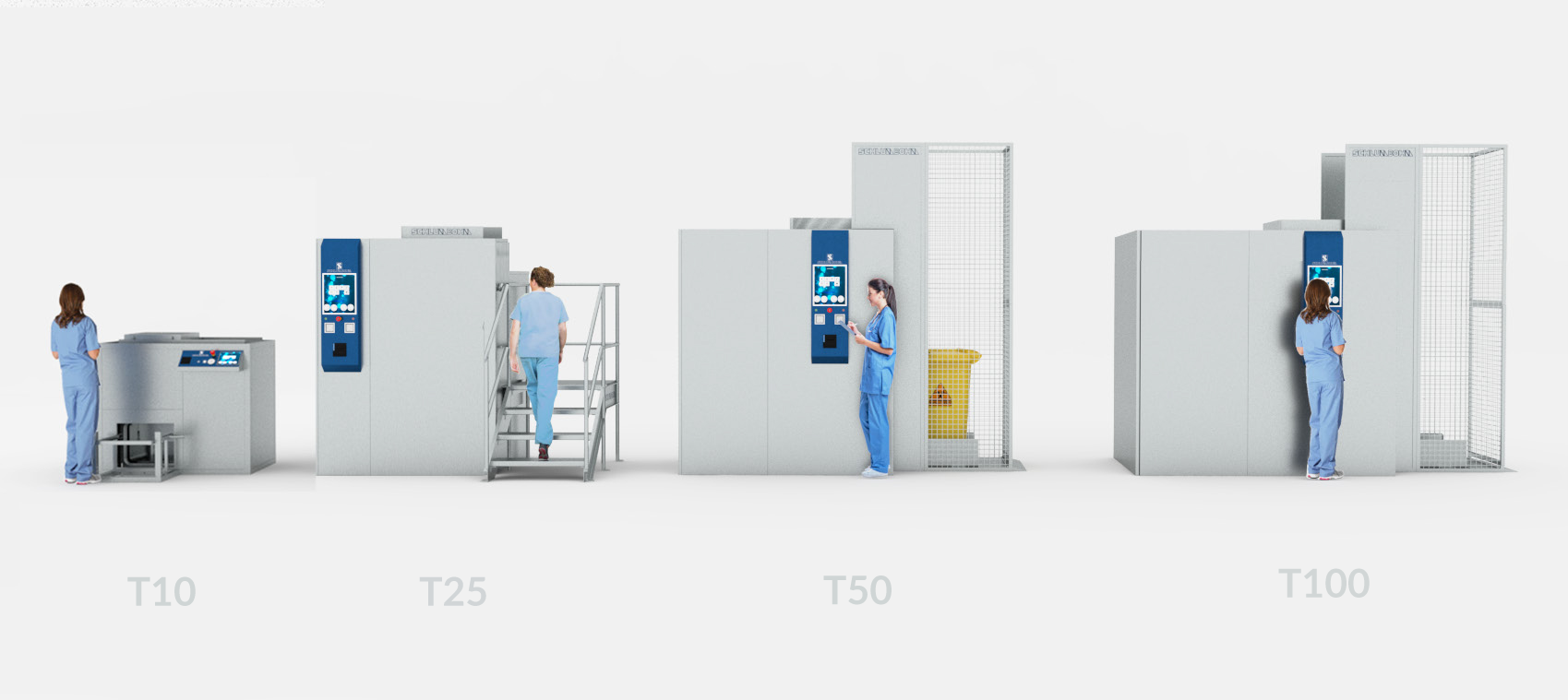
A secure and inexpensive disposal of hospital waste is becoming increasingly important when taking the steady rise in the pressures of cost and the growing demands in terms of occupational safety in the healthcare sector.
The T Series hereby combines all of the routine work steps for the treatment of infectious waste. A shredding and volume reduction by means of the integrated shredder and the subsequent steam sterilisation render expensive and uncertain transportation obsolete.
>A needs-related planning and dimensioning of the series with capacities of 135 l (T10), 270 l (T25), 614 l (T50), 1030 l (T100) and 2420 l (T200) provide for an inexpensive and safe solution for the disposal of infectious materials in hospitals that is tailored to the respective waste volume.
One of the equipment options is the automatic loading system. The filling of the waste into the chamber is carried out in the T50, T100 and T200 models, in the standard configuration, by the automatic loading system that uses 240-liter collection trolleys that comply with the UNI EN 840 standard. The system controls the lifting, overturning, emptying and return of the cart to the ground. The automatic loading system eliminates the risk of direct handling of waste and the risk of breakage and/or loss of containers and/or bags.
Download documents
Please contact our product specialists for expert advice.
We look forward to your inquiry.
Your SCHLUMBOHM-Team




